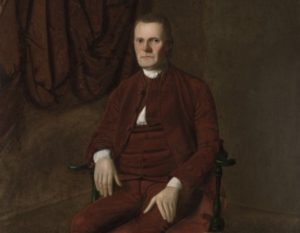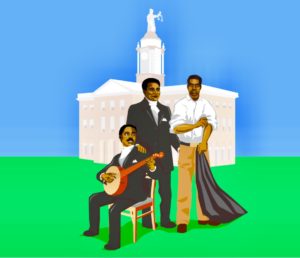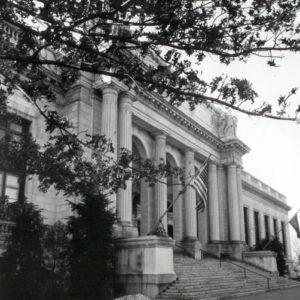News & Updates

USS Nautilus Passes Under North Pole – Today in History: August 3
On August 3, 1958, the USS Nautilus (SSN-571) made history by becoming the first ship to pass underneath the North Pole.
Read
Poet Wallace Stevens Dies – Today in History: August 2
On August 2, 1955, the great American poet Wallace Stevens died at St. Francis Hospital in Hartford.
Read
East Haven’s Revolutionary Salt Works
East Haven’s Amos Morris helped supply Americans with salt (essential for preserving food) during critical shortages brought on by the American Revolution.
Read
Fire Ravages Cos Cob School – Today in History: July 29
At 1:59 a.m. on July 29, 1990, a smoke detector signal alerted the central Greenwich fire station of a fire at the Cos Cob School.
Read
Roger Tory Peterson Dies – Today in History: July 28
On July 28, 1996, ornithologist and artist Roger Tory Peterson died in Old Lyme.
Read
North Branford Vied for the Title of “Shredded Coconut Capital of the World” – Who Knew?
Patents granted to North Branford residents included one for a device used for paring coconut meats in 1875.
Read
An American Heritage River – Today in History: July 27
On July 27, 1998, Vice President Al Gore designated the Connecticut River one of 14 American Heritage Rivers.
Read
Hope for the West: The Life and Mission of Lyman Beecher
Lyman Beecher was one of the most influential Protestant preachers of the 19th century, as well as father to some of the nation’s greatest preachers, writers, and social activists.
Read
Sanitary Fair – Today in History: July 25
On July 25, 1864, the Stamford Ladies Soldiers’ Aid Society held a Sanitary Fair in response to the needs of Civil War soldiers
Read
The Hartford Wits
Eventually taking the name the “Hartford Wits,” influential figures of the 18th century got together to write poetry that documented the state of the times.
Read
Weir Farm the Result of a Trade – Who Knew?
Weir Farm, located in Ridgefield and Wilton, Connecticut, resulted from the trade of a painting and ten dollars.
Read
Levi Pease, Stage Route and Transportation Innovator
Somers, Connecticut, a small town near the state’s border with Massachusetts, was the site of a revolution in 18th-century transportation.
Read
The First Battle of Bull Run: Connecticut Troops Stand Firm When the Battle Turns Against Them
Connecticut troops earned admiration for staying to fight when others fled at the First Battle of Bull Run during the American Civil War.
Read
Cleopatra’s Needle and Groton’s Captain Davis – Who Knew?
Cleopatra’s Needle, the Egyptian obelisk erected in Central Park across from the Metropolitan Museum of Art, arrived safely from Egypt due to the ingenuity of Noank’s Henry E. Davis.
Read
Cornelius Bushnell and His Ironclad Ship
Cornelius Scranton Bushnell was a 19th-century Connecticut businessman and shipbuilder whose successfully lobbied on behalf of a local railroad enterprise.
Read
Hammonasset State Park Serves the State and its Residents
Located in Madison, Hammonasset State Park provides visitors with opportunities for swimming, sunbathing, or strolling along the park’s meandering boardwalk.
Read
The Greenwich Avenue Fires of 1908 and 1936 Sparked Upgrades to Town’s Emergency Services
From the ashes emerged new approaches to coordinating the town’s fire fighting resources.
Read
The Connecticut Compromise – Today in History: July 16
On July 16, 1787, a plan proposed by Roger Sherman and Oliver Ellsworth, Connecticut’s delegates to the Constitutional Convention, established a two-house legislature.
Read
Trolley Campaigners Storm Small Towns and Votes for Women is the Battle Cry
In the wake of a 1912 trolley campaign, the woman’s suffrage movement rapidly gained ground across Connecticut.
Read
New England’s Grand Ambition: The Farmington Canal
Connecticut took leading role in waterway that transformed the region’s commerce.
Read
A Revolution On Two Wheels: Columbia Bicycles
Albert Pope’s company not only played a prominent role in developing improved bicycle designs, it also developed the market for them.
Read
Colt Park and the Magical Summer of 1976
In the summer of 1976, Colt Park offered rock and roll fans an escape from troubled times through a series of concerts by some legendary acts.
Read
Joseph Hopkins Twichell: Asylum Hill’s Religious Leader and Mark Twain’s Closest Friend
Inspired by his friendship with Mark Twain, Joseph Twichell took up such causes as labor rights, immigration, education, and interfaith advocacy.
Read
Sheff v. O’Neill – Today in History: July 9
On July 9, 1996, the Connecticut Supreme Court ruled that the state had an affirmative obligation to provide Connecticut’s school children with a substantially equal educational opportunity.
Read
“The Basque Game in Town”: The Heyday of Jai Alai in Connecticut
Organized jai alai came to Connecticut in the 1970s, but charges of corruption soon brought the sport to an end in the Nutmeg State.
Read
Jonathan Edwards’ Famous Sermon – Today in History: July 8
On July 8, 1741, theologian Jonathan Edwards spoke the words of the sermon “Sinners in the Hands of an Angry God” at a Congregational church in Enfield.
Read
New Connecticut on Lake Erie: Connecticut’s Western Reserve
If you drive through the area of Ohio still called the Western Reserve today, you will find towns named Norwich, Saybrook, New London, Litchfield, Mansfield, and Plymouth.
Read
The Origins and Enduring Legacy of New Haven’s Long Wharf Theatre
As a smaller, quieter alternative to Broadway, New Haven’s Long Wharf Theatre overcame an unconventional location to become a smash success.
Read
Horseshoe Nail Capital of the World – Who Knew?
In the late 19th century, George Capewell formed the Capewell Horse Nail Company, which mass produced horseshoe nails.
Read
Hidden Nearby: Goshen’s Liberty Pole
A marker on East Street North in nearby Goshen, Connecticut, allows us a window on to past celebrations of American freedoms and liberties.
Read
An Eccentric Middletown Polymath and Fossil Collector: Dr. Joseph Barratt
Despite his struggles with mental illness, Joseph Barratt was a significant contributor to the study of natural history in the Connecticut Valley.
Read
The Most Famous American in the World
In 1853, in cities and villages across Britain and Europe, throngs of admirers pushed to catch a glimpse of a barely 5-foot-tall writer from America whose best-selling novel had taken slavery to task.
Read
Furniture Caster Patented – Today in History: June 30
On June 30, 1838, the US patent No. 821—the first for a furniture caster—was granted to the Blake Brothers of New Haven.
Read
Deadly Fire at Gulliver’s – Today in History: June 30
Despite passing inspection shortly before the disaster, a fire at the Greenwich nightclub Gulliver’s in 1974 killed two dozen people.
Read
Educator Sarah Pierce Born – Today in History: June 26
On June 26, 1767, pioneering educator Sarah Pierce was born in Litchfield; during her long life, Pierce opened one of the nation’s first schools for women.
Read
Henry Ward Beecher Born – Today in History: June 24
On June 24, 1813, Henry Ward Beecher was born in Litchfield to the well-known Beecher family.
Read
Instruction by Mail: The Famous Artists School
The Famous Artists School in Westport once provided the premier correspondence training for those interested in an art career.
Read
Early Civil Rights and Cultural Pioneers: The Easton Family
For a variety of reasons, the Eastons were one of New England’s most notable 19th-century African American families.
Read
The Story of the Oakdale Makes Great Theater
The legendary Oakdale Theater in Wallingford reflects over 60 years of evolution in American pop culture.
Read
Samuel L. Clemens Receives Scrap-book Patent – Who Knew?
Writer and humorist Samuel Langhorne Clemens, better known by his pen name Mark Twain, invented more than tall tales and novels.
Read
Harkness Memorial Park Offers a Glimpse into Early 20th Century Wealth
With gorgeous views of Long Island Sound, Harkness Memorial Park is a beautifully landscaped recreation area along the shoreline in Waterford, Connecticut.
Read
Votes for A Woman: Sara Buek Crawford
As Connecticut’s first female statewide elected official and first female Secretary of State, Sara Crawford broke barriers for women throughout her career.
Read
Oliver Cromwell Launched – Today in History: June 13
On June 13, 1776, the ship Oliver Cromwell was launched in Essex, one of the largest full-rigged ships built after the establishment of Connecticut’s navy.
Read
Flying High with Early Dirigible
In what would later be described as “the first flight of a man-carrying dirigible in America,” aeronaut Mark Quinlan piloted a machine designed and patented by Charles F. Ritchel.
Read
Christopher Leffingwell Born – Today in History: June 11
On June 11, 1734, businessman and civic leader Christopher Leffingwell was born in Norwich.
Read
A Connecticut Home That Dates Back to the 1600s!
Dating back to the mid-17th century, the Thomas Lee House in East Lyme, Connecticut, is one of the oldest wood-frame houses in the state.
Read
Academy Graduates First African American Student – Today in History: June 8
On June 8, 1966, the US Coast Guard Academy in New London graduated the first African American student, Ensign Merle James Smith, Jr.
Read
The Hartford Insurance Investigator With the Action-Packed Expense Account
Based in Hartford, “Yours Truly, Johnny Dollar” was one of America’s most popular radio shows during the 15 years it aired.
Read
“Something to Show for Our Work”: Building Brainard Airport
At the height of the Great Depression, unemployed men living around Hartford, became a cheap source of labor to help build Brainard airport.
Read
Parking Authority Created in New Haven – Today in History: June 2
On June 2, 1953, the Connecticut Supreme Court of Errors ruled that creating a parking authority in the city of New Haven was constitutional.
ReadMore Articles




